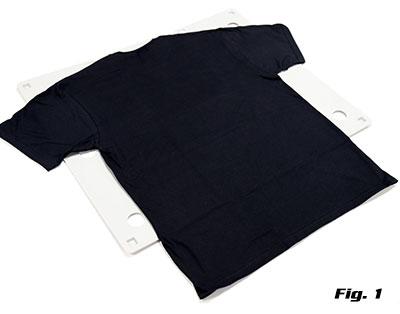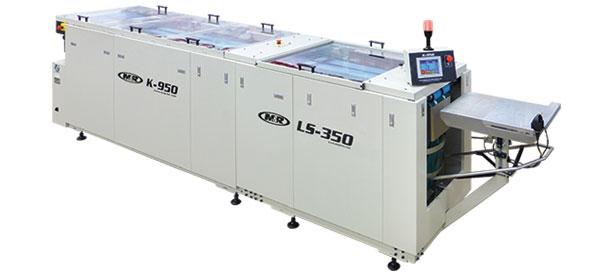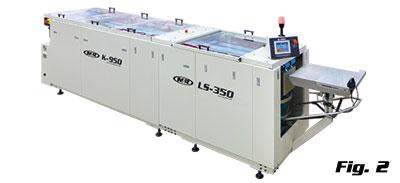When discussing t-shirt folding with business owners, the two most common questions are: "How much should it cost to fold a shirt?" and "How can I get my key personnel back to printing faster?"
T-shirt folding is often seen as downtime that is not generating revenue, so it is natural for a printer to stress about getting it done as fast as possible. The costs of having employees folding shirts are almost all labor, so in larger volumes the expense can add up quickly. Depending on the amount of t-shirts that need to be folded, there are costs and issues with each of the different methods: manual folding (unassisted), manual folding with a flip folder, semi-automatic folding, and fully automatic systems.
It's easy to focus on costs, but don’t forget about health issues
Manual folding day-in and day-out can cause a host of issues, including carpel tunnel syndrome as well as tendinitis in joints from repetitive motion. In some cases where the problem is not addressed, an employee can lose feeling and have constant pain in affected joints. Proper training can help to mitigate these issues to some degree by properly positioning the body and minimizing excess motions, but at a certain point, the sheer volume of folding shirts for hours and hours will start to add up and take a toll.
The ideal way to avoid physical issues for business owners and employees is to remove a lot of repetitive motions, but if there are huge orders of t-shirts to fold, then the choices become limited unless an investment can be made to revise the process.
Folding t-shirts manually
There isn't a lot to be said about folding a t-shirt manually other than from person-to-person, there can be a big difference in the speed at which they can fold at. It is also difficult to get shirts to conform to the same shape and size while folding unassisted, and between one person and another, there tends to be a big difference in appearance of the finished, folded garment.
A simple solution that will provide more consistency is to use a manual flip folding board (see fig. 1) as a start to create cleaner-looking folded garments that are all the same outside dimension, regardless of size.
What does folding shirts unassisted or with a flip folder board cost? You can divide the number of garments by the rate of speed of the person folding. A typical worker can fold a garment to achieve a quality result in about 15-20 seconds, which equals around 200 t-shirts per hour. If that person is being paid $12 per hour than that comes out about .06 cents per shirt. The real issue is that this is the only thing that person is doing, and a skilled worker will cost far more when you add up the higher cost of their hours. The other concern is that a skilled employee cannot do other activities that earn far more money, like print shirts! In this sense it is critical that a busy business keep the skilled labor doing the skilled work that earns higher amounts for their invested time.

Automatic solutions to folding t-shirts
When your volume of shirts get high enough, you should ask a couple of questions to help determine what automatic solution you may consider:
- How many folded garments are you currently achieving per hour?
- Where do you need to be in regards to folded shirts per hour?
- Do you need other accessory services like bagging and labeling?
Using a flip-folding board can get a company started, but at a certain volume, it can be too costly to stay with. The next level could be a semi-automatic unit which can fit a certain market niche, depending on your size of company and the typical order size. Some of these machines will handle a portion of the process, like flipping the shirt over for each fold, and let you do the loading and unloading.
At the higher volumes, a fully automatic machine (see fig. 2) can consistently fold 1,600 shirts per hour with one operator using an industrial folding unit. Adding additional steps to this, like bagging and adding a label to a bag, can be completed at a rate of 1,200 per hour.
The important things to consider are the types of services that your customer base is requesting. Do they need additional services, like bagging and labeling? What about tags and barcodes? Asking these types of questions will help to visualize the process that you need to consider. Ask yourself this extra question: What services do you feel you need to offer to be competitive in the markets you want to grow in?
At a certain point, an automatic bagging and labeling machine could be the right solution. Keep in mind that there's an additional benefit with a fully-integrated folding/bagging/sealing/labeling system: those combined processes require a single operator. Every step after loading the garment on the folder happens automatically. Labels can be affixed to the garment prior to bagging and/or after bagging. Manual finishing just doesn't come close to time and labor vs. results, and often the increased efficiency alone will justify the investment.
A folding solution
The right solution for your company will relate to a combination of variables. An average of your typical orders, your employee workload and labor costs, and the overall demand from your customer base can be a few ways to start to look at solutions. A way to solve your needs is to consult with another company that is currently using a solution similar to what you are looking at, or contacting an industry expert that can help you determine the most cost-effective process that will help your employees and your bottom line at the same time. Addressing shirt folding with outside help is a way you can also avoid potential health issues in the future, and get your shirts folded and looking great while saving money and labor.

About the Author
- Email Address john.murray@mrprint.com
- Phone 1-630-390-4147
M&R Product Manager
The M&R Companies
Toll-Free: 800 736 6431
Mobile: +1 630 390 4147
john.murray@mrprint.com





